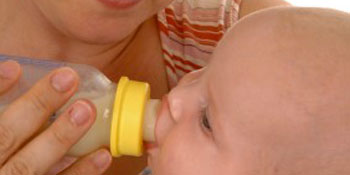Introducing a Bottle to a Breastfed Baby
At some point during the first year of life, most babies will need to be bottle fed. Some newborns receive their first bottle in the hospital as a medical intervention due to low sugars, jaundice, or when their mom is unavailable to breastfeed. However, the majority of breastfed babies do not get a bottle for at least the first month of life while breastfeeding is being established. At some point, Mom might yearn for a night out with her husband/partner, a coffee date with a friend, or just a trip to the grocery store without her baby. She may also be planning to return to work outside of the home. Therefore, it’s a good idea to introduce a bottle to a breastfed baby early on to ensure she will take a bottle when she is away from mom. The best time to introduce a bottle is between 4-6 weeks of age. At this time, breastfeeding is typically well established and baby is young enough to be open to an alternate feeding method. Some babies are reluctant to take a bottle from mom, so it’s a good idea to have someone other than mom introduce the first bottle.
Bottle Preparation: Pour the desired amount of milk into a bottle and warm it up by running it under hot water or using a bottle warmer. Remember, your baby is used to drinking milk from your breast that is about 98 degrees, so she is used to drinking very warm milk. Some babies are open to taking milk that is cooler than they are used to from a bottle, whereas other babies are fussier about the temperature of the milk. Pour a few drops of milk on your inner wrist to test the temperature before offering it to your baby, to make sure it doesn’t feel too hot to the touch. Never heat milk in the microwave as the milk does not heat evenly and may contain hot spots that are an unsafe temperature for your baby.
Positioning: When offering a bottle, hold your baby upright on your lap and hold the bottle in a horizontal position. Stroke your baby’s lips downward from under her nose towards her chin quickly, as this will stimulate her reflex to open her mouth. When she opens her mouth, insert the bottle far enough back to let her lips rest on the base of the nipple, not on the narrow tip, to replicate a deep latch. Hold the bottle horizontal throughout the feeding, letting the milk fill the nipple about half way. Many parents are concerned that their baby will ingest air when holding the bottle this way. Your baby will definitely ingest some air from the bottle, and it will be important to burp her half way through the feeding and again at the end of the feeding, to keep her comfortable. Babies actually get more of an upset stomach if the bottle is held upside down during a feeding, when baby is forced to continue sucking and swallowing quickly (“chugging”) because the milk is pouring out at them. When a baby is fed this way, she is not able to take any breaks to slowly swallow and breathe, which can be very stressful for her. Also, babies are born with a very high suck need. If a baby is fed too quickly, she will continue to show hunger signs after finishing the bottle, not because she is still hungry, but because she did not get her suck need fulfilled. This can lead to over-feeding, fast weight gain, stomach upset and fussiness. Pacing the bottle feeding allows your baby to suck, swallow and breathe at a pace she is comfortable with, which is similar to breastfeeding. It is a more respectful way of bottle feeding your baby, giving her more control to take breaks from sucking without milk pouring into her mouth, forcing her to suck and swallow. Don’t worry if your baby stops sucking during the feeding. Simply hold the bottle in her mouth and wait for her to start sucking again. Ideally, in order for a baby to get her suck need fulfilled and for her stomach to remain comfortable, a bottle feeding should last at least 15-20 minutes.
Frequency: Continue to offer your baby a bottle at least three times per week to keep her interested in feeding this way, to ensure she will take a bottle when you cannot be with her. Remember to use an electric breast pump to pump both breasts for 15 minutes anytime your baby gets a bottle, in order to protect your milk supply.




Recent Comments